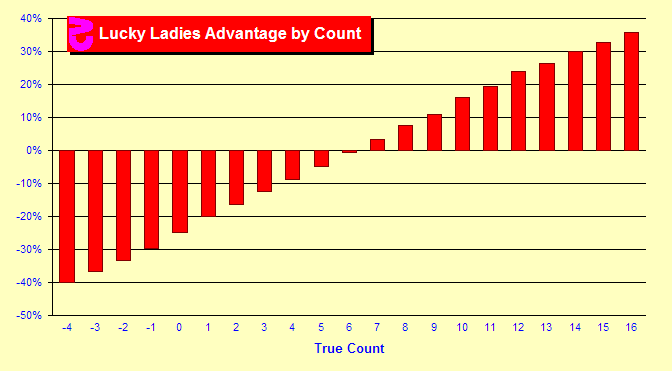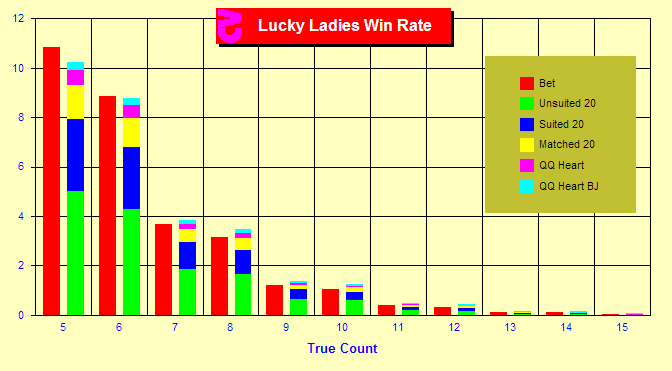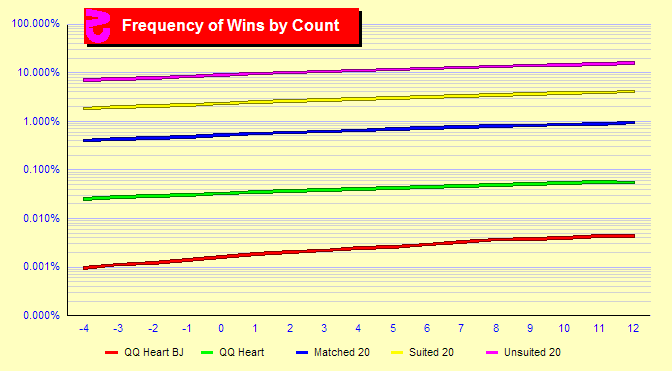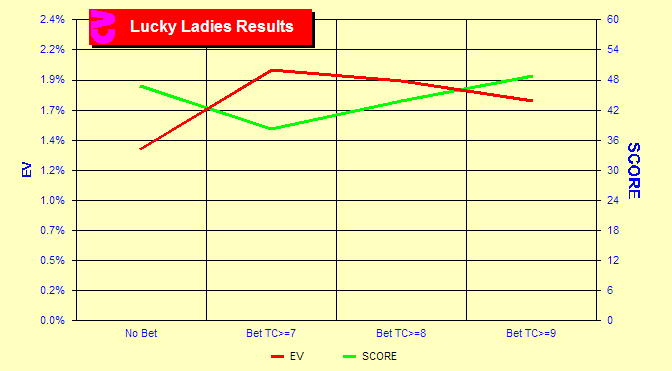|
|
Chapter 12. Side Bet Data
|
First a few general comments on side bets. Competition caused
by growth in the casino industry has resulted in numerous new side
bets including: 21+3, Big Slick, Bonanza BJ, Dare any Pair, Field
of Gold, High Tie Bonus, Lucky Ladies, Lucky Lucky, Match the Dealer,
Over/Under, Pair Square, Perfect Pairs, Royal Match, Super 7's,
Sweet 16 and Streak. Most side bets have shockingly large house
advantages and should be avoided at all costs. However, some can
be beaten. In some cases the normal card counting strategies are
used. You can increase the edge by using specialized side counts
— but these greatly complicate the game. Some side bets, like
Red/Black, require specialized counts. Newer side bets usually include
multiple payoffs. For example, Lucky Ladies pays different amounts
for Two Queen of Hearts and a dealer BJ, Two Queen of Hearts, a
matched 20 (two identical cards adding to 20), a suited 20 and an
unsuited 20. Also note that some side bets have a fixed or maximum
bet amount, a capped payout or a bet size relative to the main bet.
Also, different casinos may have different payout tables for the
same side bet. The payouts for Lucky Ladies used on this page are
1000:1, 125:1, 19:1. 9:1 and 4:1.
"These foolish games are tearing me apart" —
Jewel, 1999
|
|
 How
do we card count Lucky Ladies? How
do we card count Lucky Ladies?
Let us look at the Lucky Ladies side bet using standard Hi-Lo as
the card counting strategy. First the good news. Although LL has
an outrageous 25% house edge at a true count of zero, the advantage
changes dramatically as the count changes. This chart plots the
advantage by true count. We can see that the advantage turns positive
at true count +7 and continues to increase substantially above that.
So, if we make the side bet only with a TC of +7 or higher, we gain
a theoretical advantage and "beat" the side bet. So far,
so good.
|
 Where
do I win? Where
do I win?
Let's look a little more deeply. The next chart displays only true
counts of +5 to +15. The red bars indicate the amounts bet on Lucky
Ladies assuming that you always make the side bet. The other colors
indicate the amounts won. You will note that the red bar is taller
at true counts of +5 and +6 indicating these are bad bets, and shorter
at higher counts indicating positive EV bets. But, the winning amounts
have been broken down into the five different payouts.
What we see here is that half of the return comes from the winnings
for unsuited 20s, represented by the green bar. This is good news
as variance would be too high if a rare event was behind most of
the overall payoff.
The cyan colored area at the top of the payoff bars represents
the 1000:1 payoff for a pair of heart queens and dealer Blackjack.
The payoff is 1000:1, but it only occurs about 1 in 70,000 hands
in a six-deck game. The amount is relatively small, but our actual
results will vary an appreciable amount depending on whether we
receive 0, 1 or 2 of these hands after playing a huge number of
hands. What this means is that although we have a theoretical edge,
at counts of +7 and +8, a major part of our advantage depends on
a rare event. This adds to our risk.
|
|
 How
often do I win? How
often do I win?
This chart shows the frequency of wins for the five different
payouts by true count. The y-axis uses a logarithmic scale because
the differences in frequencies are so large. All payouts increase
in frequency as the count increases. The red line indicates the
frequency of the top payoff. We can see that at a true count of
+7 it occurs about .003% of the time.
|
|
 What
are the overall results? What
are the overall results?
This chart is a quick look at overall results both in terms of
EV (expected value or advantage) in green and SCORE in red. The
first column provides EV and SCORE for Hi-Lo if we never take the
Lucky Ladies bet. The EV scale can be found at the left and SCORE
scale at the right. Now let us make a LL bet equal to our max bet
with all counts of +7 and above. We see that the EV climbs from
1.35% to 2%. But, the SCORE drops. This is because SCORE is risk-based
and includes the standard deviation of the Lucky Ladies side bet.
The SD is much higher with LL. So, let's try increasing the point
at which we make the bet. If we make the bet only with a true count
of +9 or higher, the SCORE and EV are both higher than when making
no bets at all. However, the count is rarely that high.
In conclusion, yes we can make money at this bet. But unless the
penetration is very deep, the bet is not as good as it first looks.
|
|
Sim details
- Six decks, S17, DAS, Heads-Up, Hi-Lo, truncate, Sweet 16 indexes,
half-deck resolution, penetrations 5/6 penetration, Spread $10-$150
- Five-ten billion rounds each
|
|
|
 How
do we card count Lucky Ladies?
How
do we card count Lucky Ladies? Where
do I win?
Where
do I win? How
often do I win?
How
often do I win? What
are the overall results?
What
are the overall results?